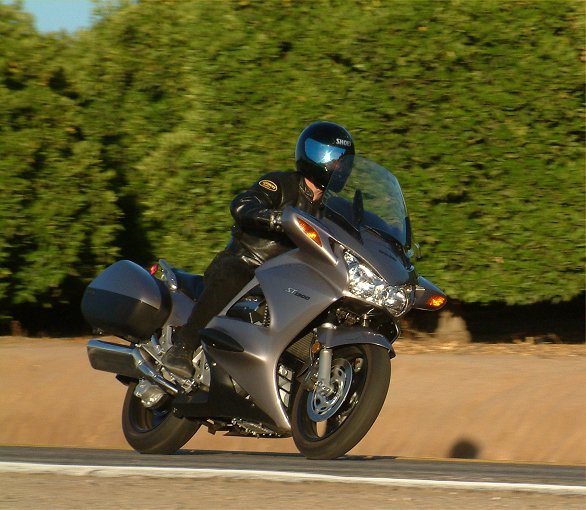
Some bikes emphasize performance at the expense of long distance comfort and convenience, while some place their emphasis on the comfort/convenience side at the expense of outright performance. Without starting an argument, for purposes of discussion, let’s say that a Ducati 998 is at the performance end of the spectrum, while a Honda Gold Wing is at the opposite, long-distance comfort/convenience end of the spectrum. Can a machine combine the performance capabilities of a 998 (current WSB champion) with the comfort/convenience of a Gold Wing? No . . . not with current technology and materials science. But this is not the end of the story.
You simply cannot come close to using all of the performance available from a Ducati 998 on the street (Troy Bayliss can controllably drift both ends of this bike at full lean at 120 mph, okay?). So the possibility exists that a bike can combine extremely high levels of street performance (just about as much performance as you can sanely use) with the comfort and convenience necessary to make long distance touring not only achievable, but enjoyable. Motorcycling’s Holy Grail.
We are not going to call the 2003 Honda ST1300 motorcycling’s grail, but it is one hell of a bike. In our opinion, the new benchmark in the luxury sport tourer category. It is not without its flaws, but it can offer the rider who wants sporting performance and long-distance comfort just about all he can handle (or need) on both fronts.

As we said in Part One of this review, the ST1300 is the successor to the ST1100. The ST1100 is a well-respected sport tourer, with a large, loyal following, but it is a twelve-year-old design. We would expect Honda to comfortably exceed the standards set by the ST1100 in virtually every category with the new ST1300. It has.
The ST1300 keeps the configuration of the ST1100 engine, but virtually nothing else. Still a 90-degree V-4 situated longitudinally, the new engine is 16% larger in displacement (1261 cc compared to 1084 cc) with the “big bore/short stroke” design popular in current sport bikes and racing machines. Honda claims 125 horsepower at the crank at 8,000 rpm, with 85 pound feet of torque at 6,000 rpm. The bigger displacement and the sportier bore/stroke ratio are just part of the performance boost received by the ST1300. Significantly higher compression (10.8 to 1 versus 10.0 to 1), as well as much larger valves, also play a role. The result is engine performance that significantly exceeds the ST1100 everywhere, from bottom to top.
As you would expect given Honda’s recent track record, the ST1300 is now fuel injected. Incorporating a throttle sensor, and 3-D injection and ignition mapping, Honda was able to achieve much higher performance levels while meeting the most stringent emissions’ requirements (California Air Resources Board standards for the year 2008).
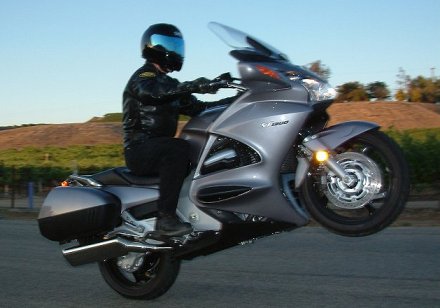
The new motor runs even smoother than the old one thanks, in part, to dual engine counter balancers that virtually eliminate primary and secondary vibration. Honda did this as much to improve handling as to improve rider comfort — the smoother engine can be solidly mounted to the chassis as a stressed member for improved rigidity and reduced weight.
The engine contributes to performance in another interesting way — by being significantly more compact. A full two inches shorter than the ST1100 mill, the new, larger displacement engine benefits from a relocated crank shaft, lighter and narrower cam chain, and more closely integrated five-speed gear box.
The physically smaller engine can be located further forward in the new, aluminum frame (the ST1100 had a steel frame). Combined with a seating position that places the rider 1.6 inches closer to the front wheel, Honda dramatically changed the weight distribution of the new machine.
The ST1300 chassis is a huge 2.5 inches shorter in wheelbase, with a steering rake 1.3 degrees steeper. Combined with the increased weight over the front end, and the stiffer aluminum frame, Honda achieved much quicker, more precise steering without a loss of stability.

Chassis improvements continue with the braking system, which features Honda’s LBS (Linked Braking System), now in its third generation. Although the front and rear brake levers continue to operate brakes at both ends, the effect is much more subtle and sophisticated than earlier Honda attempts (Honda did get it right on the Gold Wing, however). The dual 310 mm front rotars (gripped by three-piston calipers) and the single 316 mm rear rotar (gripped by a single-piston caliper) work exceptionally well.
In keeping with the increased rigidity offered by the new aluminum frame, Honda fitted beefy 45 mm forks (the largest fork tube diameter offered on a ST1100 was 43 mm). Offering 4.6 inches of travel, the fork is not adjustable, but the compromise setting offered by Honda is very good (more about this below). Out back, a single shock with 4.8 inches of travel is adjustable for spring preload.
At a claimed 624 pounds dry (637 for the ABS model), the ST1300 is only twenty pounds or so lighter than the ST1100, but massively more rigid thanks to the aluminum frame, stressed-member engine, beefier forks, etc.
The fuel range of the ST1300 is huge, thanks to a 7.7 gallon fuel tank (17% larger than the Gold Wing fuel tank) and our observed 42 miles per gallon. Yielding a theoretical 323 miles between fill-ups (we got more than 300 miles before filling up, once), the ST better be comfortable if its pilot is going to stay in the saddle the entire time between gas stops.
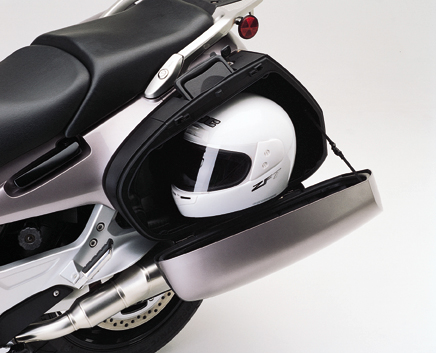
Comfortable it is. A well-shaped and firm rider seat offers nine possible positions (the seat has three height positions, and three fore/aft positions, which can be used in any combination). The bar/seat/peg relationship leaves the rider almost bolt upright, with a slight forward lean of the torso. The fore/aft seat adjustment allows you to shorten the reach to the bars, if desired.
A large, protective fairing is fully adjustable at the push of a button (on the more expensive, ABS version) or manually adjustable to two positions (on the non-ABS base model). With only a handful of machines in the United States at the time of our test, we were only able to test the manually adjustable version.
In its higher position, the manually adjustable shield will require that shorter riders look through it while riding — something that takes getting used to. Even in the shorter of the two positions, the shield is fairly tall, although Willy and I (neither of us giants — both well under six feet tall) could easily see over it, particularly, with the seat set in the middle or highest adjustment position.

The shield creates a very comfortable air space for the rider, particularly, in the higher position. The lower position results in some minor back pressure pushing the rider towards the bars.
Fairing protection is very thorough for the rider, as a whole. The mirrors act as wind deflectors for the hands, and even the lower legs are protected adequately from the wind.
Instrumentation is thorough, to say the least. The laundry list of information provided by the ST1300’s guages and LED read-outs is long. Indeed, the instrumentation is as thorough as most modern automobiles, with trip meters, the obligatory speedometer and tachometer, ambient temperature, engine temperature, digital fuel guage, and even a computer that can tell you both current and average miles per gallon. Along with assorted warning lights, the ST even has a remote, electrically adjustable head light angle (adjusts over a 2.5 degree range) insuring proper lighting of the road ahead from the excellent headlights regardless of passenger or luggage load.
Passenger accomodations are on the generous end of the sport touring scale, as is the luggage capacity. Twin, 35-liter, lockable, detachable saddlebags are easy to use and clearly well-made. A large helmet will fit in each bag with ease. Two glove boxes (one lockable) are available on either side of the instrument cluster.
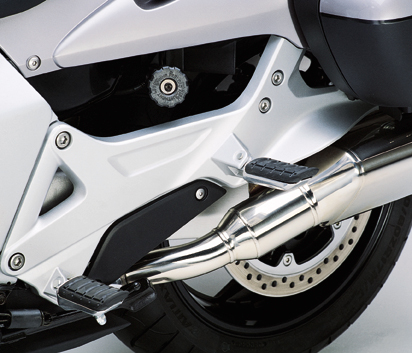
The shaft drive system insures low maintenance, and other maintenance items (such as the oil filter) are easily accessible to the shade tree mechanic.
Pop out mirrors can bump into things (and pop out) without damage, and the fairing has stylistically integrated bumpers on either side to minimize damage in the event of a tip over. We tested both of these features first hand.
First, Willy bumped mirrors with a truck while splitting lanes on the freeway, the mirror popped out and, to his surprise (and delight) suffered no damage whatsoever, and popped easily back into place. The fairing bumpers were tested when a large SUV backed into our parked ST1300 at the local motorcycle shop, slowly tipping it over into the adjacent planter. Although the curb next to the planter cracked the saddlebag on the right side of the bike, the bumper prevented any additional damage to the bodywork of the bike.
If you are still with us, we can tell you what it is like to ride the ST1300. In a word, it is a delight. All of Honda’s engineering and testing of this model, and careful attention to mass centralization and rolling axis (note the purposefully repositioned engine crank and the 2.2 gallon remote gasoline tank located low in the chassis with the fuel pump, for instance), makes the ST1300 feel fully 100 pounds, or more, lighter than the ST1100 when riding. “Nimble” is not a word you would normally associate with a motorcycle weighing more than 600 pounds, but it does describe the handling of the ST1300.
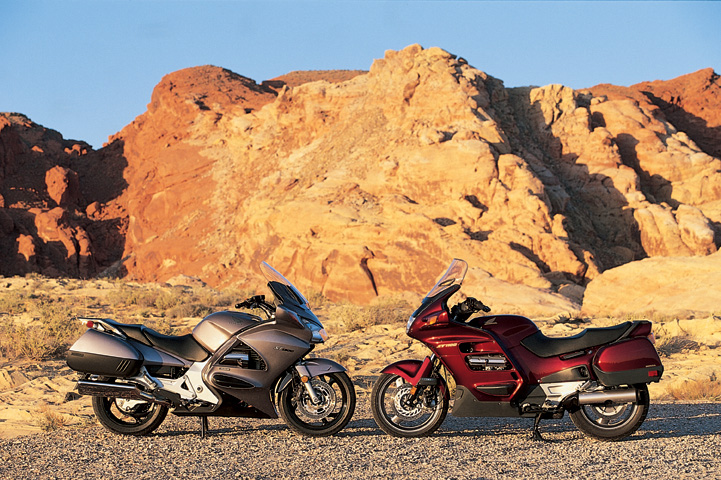
The stiffer chassis, shorter wheelbase and dramatically more aggressive steering geometry transform the feel of the new ST. Like it did with the Gold Wing last year, Honda has made a slight reduction in weight translate into a quantum leap forward in terms of agility.
Moreover, the ST1300 is just plain fun to ride. Excellent feedback gives the rider confidence. The V-4 engine has all the power you will need, and it delivers that power with a silky smoothness, yet a distinct, likeable character (anyone else getting a little bored with in-line fours?)
The ground clearance in corners is surprisingly generous, with the footpeg feelers giving first warning that limits are near. In fact, the ST1300 urges you to use all that clearance with a planted, “this is no sweat” attitude at lean angles that would make other big tourers wobble (and even crash).
The suspension is very well set up to handle everything from freeway stutter bumps to mid-corner jolts. The fork and shock (with its convenient, remote preload adjustor) never felt overwhelmed by aggressive riding.
Things we didn’t like? A few. Some heat radiates from the fairing lowers on to the rider’s shins, but this only became noticeable while riding at lower speeds or in extreme heat. Surprisingly, the amber digital readouts (even in their brightest of three selectable intensities) could become difficult to read in bright sunlight (particularly, if you were wearing a tinted visor). Finally, some minor driveline lash at lower rpm’s was initially annoying, but time in the saddle meant a little throttle and clutch technique eliminated it, altogether.
We were tempted to add the price ($12,999 for the base model and $14,499 for the model with ABS and electric windshield) on our list of negatives, but the ST1300 is clearly worth every penny to the hard-core sport tourers who will keep a bike like this for many years and tens of thousands of miles.
Take a look at Honda’s web site for additional details and specifications.





